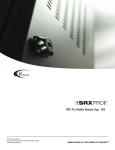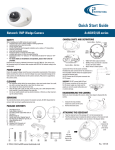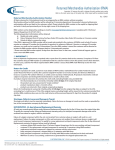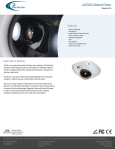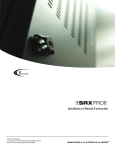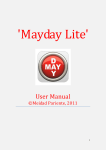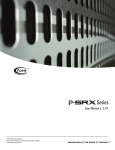Download Quick Help Guide (via SRX-Pro Remote)
Transcript
Quick Help Guide (via SRX-Pro Remote) ©2012 i³ International Inc. The contents of this user manual are protected under copyright and computer program laws. Page 2 SRX-Pro Remote - Quick Help Guide Logging In Double-click the SRX-Pro Remote shortcut on your Desktop to launch the application. Next, enter the SRX-Pro Remote password, default is “i3dvr”. The SRX-Pro Remote window will open. Locate the Server you would like to connect to in the Servers list and click the Connect button. NOTE: All remote servers should already be on the list and each connection should be configured with your unique login name and password. If the Remote server you’d like to connect to is missing from the Servers list, or if you are having trouble connecting to your remote Server, please contact your installer for help. Page 3 Once you are connected, the list of all available video channels will be displayed along with the lists of connected Sensors and Controls (if applicable). In the example below, i3 SRX-Pro Remote is currently connected to the “118-628” remote Server and a list of 24 channels is displayed below. Searching Recorded Video DVR/NVR technology allows you to view recorded view remotely without having to travel to the physical store. You may want to review video recorded in the past few minutes/hours or you may want to search for an incident that was recorded yesterday / last week or even month, when applicable. The instructions on the next page will show you how to review video recordings on your remote DVR system. i³ International Inc. 780 Birchmount Road, unit 16 Toronto ON M1K5H4 Canada Tech Support: 1.877.877.7241 www.i3international.com Page 4 Single Camera Video Search (Live Mode) If an incident has just occurred and you would like to review recorded video on one of the cameras, follow these steps. Start by connecting to the location you are interested in by following the instructions in the Logging In section. Once you have connected to the remote Server, follow instructions below to search for the video recorded since 12AM of the current calendar day. Note: To search for the video recorded earlier, please see the next section. 1. Select one or more cameras in the Channels tree list on the left hand side and drag them into the Live View screen. To do that, position the mouse cursor over the camera of your choosing in the Channels tree list, press and hold the left mouse button, drag the mouse cursor over to the Live View screen on the right hand side and release the mouse button. The live video stream of the selected camera(s) will be displayed. In the example below, Channel #5 has been selected for review. 2. Double-click on the video image to bring it into Full Screen mode for best results. (This step is optional). 3. Right-click on the video image and select “Search Mode” from the context menu. (Context menu has been enlarged for demonstration purposes) Page 5 4. A 24-hour timeline will be displayed. The colored bars represent the video recording. The timeline is zoomed into for ease of use. To search beyond the time frame that is initially displayed on the time line, right-click on the time line and select Zoom Out option from the context menu. Repeat to fully zoom out. Channel # Colored bars represent video recording Red oval represents the playback start time. Video Playback Control buttons: Reverse, Stop, Play 5. Move your mouse cursor over the time line. Let your mouse cursor rest for a moment to view the exact time code of the spot where the cursor is pointing to. Position the cursor over the timeline and left-click to select the start time for the play back. Click one of the control buttons to start viewing the video recording. Click the Play button to start/resume playback. Click again to increase the playback speed (1X, 2X, 4X, 8X, 16X) To stop playback, click the Stop button Click the Reverse button to reverse playback. Click again to increase the playback speed (1X, 2X, 4X, 8X, 16X) Once you are done viewing the video, you will want to return to the Live screen to continue viewing the live video stream from selected camera(s). To do so, right-click on the video image and select Live Mode option from the context menu. Finally, double-click on the video image to return to the split-screen mode. i³ International Inc. 780 Birchmount Road, unit 16 Toronto ON M1K5H4 Canada Tech Support: 1.877.877.7241 www.i3international.com Page 6 Multi-Camera Video Search (Search Mode) If an incident has occurred before 12AM of the current day or if you’d like to view recorded video from multiple cameras at the same time, follow the instructions below: 1. Start by connecting to the remote location you are interested in by following the instructions in the Logging In section. Once you have connected to the remote Server, follow instructions below to search for the recorded video. 2. On the main screen, locate and click the Search button in the top left corner of the screen. The Search window will be displayed. (1) Display Window (6) Playback Control Panel (2) Screen Division Panel (7) Channel selection for search (3) Time Panel (8) 24-hour Timeline (4) Tools Panel (9) Current Time/Date (5) Advanced Search panel/ Image Settings Panel Page 7 3. Select the “Channels” item in the tree list on the left hand side and drag it into the Display Window screen (1). To do that, position the mouse cursor over the camera of your choosing in the Channels tree list, press and hold the left mouse button, drag the mouse cursor over to the Display Window screen on the right-hand side and release the mouse button. The recorded still images for each camera will be displayed. 4. Click the Deselect All button in the Channel selection for search area (7) and then select only the cameras that you would like to search by clicking on the corresponding buttons. Scroll to see additional channels past Channel 7. As you select the cameras for review, the channel buttons and their corresponding timeline row will be highlighted light blue. The colored bars inside the 24-Hour Timeline (8) represent video recording for each individual camera. The color of the bar indicates the type of video recording, i.e. Motion = Navy Blue, Pink - Continuous, Sensor + Motion = Green, etc. 5. To view the video recording for a specific incident, please select the day the incident has occurred in the Calendar located in the Time Panel (3). The days in red color contain video recording. The days in blue color contain no video recording. The day in a filled gray oval is the day selected for review.The day circled with a red line is the current calendar day. E.g. July 22, 2011 in the image is the current calendar day, while July 21, 2011 has been selected for review. June 27-30, as well as July 4-7, 12, 21-22 all have video recording. 6. After selecting the day of the incident, select the start time of the video recording on the Clock window located in the Time Panel (3). Use keyboard or mouse cursor. i³ International Inc. 780 Birchmount Road, unit 16 Toronto ON M1K5H4 Canada Tech Support: 1.877.877.7241 www.i3international.com Page 8 7. Once you’ve selected the incident’s Date and Time, click the Play button on the Playback Control Panel (6) to start viewing the video recorded by the cameras you have selected in Step 4. At any time during the playback, you can zoom into any of the selected cameras without interrupting the video playback. Simply double-click on the camera you’d like to bring to a Full Screen mode. When done, double-click again to go back to the split screen mode. 8. Use the Playback Control Panel (6) to navigate video playback. You can increase/decrease the speed of the playback by using the Speed slider, you may stop or reverse playback, or view video recording frame-by-frame. Once you are done viewing the video, you may want to: I) go back to viewing live view recording. To do so, click the Live View button II) stop playback and run another video search. To do so, click the Stop button and then repeat Steps 4-8 of this section. III) run an Object Search on a selected camera or backup a portion of your video recording to a CD/DVD/USB, in order to present it to the law enforcement agent, for example. Read the next two sections to learn how. Object Search Object Search allows looking for a change within a highlighted area of the camera field of view. This feature can save you many minutes/hours of viewing recorded video footage to find a specific incident. For example, Object Search will help you quickly find a video recording of a moment of when a car has parked on a reserved parking spot or when an object of interest (e.g. a display stand in a store) was moved. Object Search can be only performed on one camera at a time. Object Search can be only performed within a single calendar day at a time. To narrow down your search, highlight only the area of interest. The completed rectangle are can be re-sized or moved around on the screen. Up to 8 (eight) search areas can be drawn. Page 9 Follow these instructions to perform the Object Search: 1. In Search Mode, Select the “Channels” item in the tree list on the left hand side and drag it into the Display Window screen (1). To do that, position the mouse cursor over the camera of your choosing in the Channels tree list, press and hold the left mouse button, drag the mouse cursor over to the Display Window screen on the right hand side and release the mouse button. The recorded still images for each camera will be displayed. 2. Select the day the incident has occurred in the Calendar located in the Time Panel (3) 3. Click the Deselect All button in the Channel selection for search area (7) and then select only the camera that you would like to perform Object Search on by clicking on the corresponding button. Scroll to see additional channels past Channel 7. 4. Double-click on the still video image of the selected camera in the split-screen mode to zoom into the selected camera. The selected camera will be then be brought into Full Screen mode. 5. Click on the Object Search button in the Advanced Search panel (5). The Object Search panel will be displayed on the left-hand side. 6. On the Display Screen, draw a rectangular area where the Object Search will be performed. To draw a rectangular area on the screen, position your mouse cursor over one of the corners, press and hold down the left mouse button, drag your mouse cursor in the desired direction until a rectangle has been drawn. Release the mouse button. Calendar Display Screen Object Search Panel Camera Selected for Object Search Object Search Area Object Search Button Page 10 Only highlighted video area(s) will be processed during the Object Search, which allows for faster and more efficient search times. 7. In the Object Search panel, configure the Start and End Time for your Object Search. If you are able, narrow down the search time to a shorter period of time to reduce the Search time and the number of returned results. In our example, it is known that the motorcyclist parks in a reserved spot some time between 7:50AM and 8:20AM. 8. Set the Interval if you do not want to check every video frame within the set time range (optional). This setting allows to further speed up the search and produces fewer search results. In our example, we will check for the changes within the highlighted video area only every 30 seconds during the set search time range. 9. Click the Start button in the Object Search panel to begin the Object Search. Thumbnails with search results will be displayed below. Wait until the Object Search is complete. Once the Object Search is done, you can scroll through the search result thumbnails below and view them in Display Screen by clicking on the individual thumbnails. In our example, we can see that the motorcyclist arrived around 7:56:30AM. Display Screen Once you have completed the Object Search, you may want to: I) go back to viewing live view recording. To do so, click the Live View button Page 11 II) perform another Object Search. To do so, double-click on the Display Screen to go back to split screen mode and repeat Steps 2-9 of this section. III) perform a video search. To do so, double-click on the Display Screen to go back to split screen mode and repeat Steps 4-8 of the Multi-Camera Video Search (Search Mode) section of this guide. IV) backup a portion of your video recording to a CD/DVD/USB, in order to present it to the law enforcement agent, for example. Read the next sections to learn how. Video Backup Occasionally you may want to save a portion of your video recording to a removable media, such as CD/DVD disk or a USB drive. To perform video backup, follow instructions below. In Search Mode, click the Backup button on the Tools panel (4). The Backup Search Mode window will be displayed. 1 5 4 3 2 6 7 Page 12 Use the diagram on the previous page to help you follow along with the instructions. 1. Start by configuring the Start Date/Time and End Date/Time of the video clip you would like to back up. 1 Be mindful of the length/size of the video recording backup. The longer the backup video recording, the bigger the file size will be and the longer the backup process will take. Keep in mind that a 1-minute AVI clip of a Full HD video recording recorded at 15 frames per second, will take up around 370MB. Based on this assumption, a standard DVD disk will only hold around 12-15 minutes of full HD video recording. 2. Next, select one or more cameras you would like to back up. A separate backup file will be created for each camera you select. The start/end date and time of the backup will remain the same for all selected cameras. 2 3. Click on the Video Settings tab and select AVI video format (as shown in the image below). 3 4. This step is optional. For the ease of identification, you may want to add a timestamp to your video backup clips. To add embedded text to your video backup, click on the AVI Text Embedding tab. 4 Select the text location in the Text Alignment menu and then select the type of text you’d like to add in the Text Format. You can add a timestamp only, or you can combine it with Server IP address, Channel name, and/or Frame count. Page 13 5. Make sure the backup Destination is set to Local Storage. 5 If you would later like to create a DVD backup, you must first save video clips onto your local drive and then burn the DVD backup using Windows utility software. Next, select the exact backup location on your hard drive, click on the button highlighted in the image below to select the folder where the video clips will be saved to. The default backup location is D:\i3dvr Backup. Click this button to change the folder where your video backup clips will be saved to. The Backup File Name window will pop up. In this window you will define the default location for all backup video clips as well as a default video backup clip name. Click this button to locate the new folder where your video backup clips will be saved to. If you would like to save the backup clips to your USB drive, plug it in now and locate it in the drop-down menu. Position the cursor inside the File name: field and type a new name for your video backup clip. Make it as descriptive as you want. It may be useful to include the video clip date/time, camera location and the incident name in the file name to help you identify it later. E.g. 2011June17-ParkingLot-Motorcyclist.avi Note that by default, your custom file name will be accompanied by the remote Server’s IP address, channel number, Clip Name, video resolution and frame rate of the recording. i³ International Inc. 780 Birchmount Road, unit 16 Toronto ON M1K5H4 Canada Tech Support: 1.877.877.7241 www.i3international.com Page 14 6. Click the Add button to add the configured backup clip to the backup lineup. 6 7. Click the Start button to begin the backup process. 7 The clip status will change from “Ready” to “Active: % completed” and to “Finished”. Wait until the backup clip status says “Finished”. Your backup is now complete. If you were backing up video to a USB drive, safely disconnect it from your PC now. If you would like to burn the saved clip to the DVD disk, insert the blank media into your DVD drive now and use Windows burning utility to burn your clip(s). You may refer to Windows Help guide for instructions: http://windows.microsoft.com/en-US/windows-vista/Burn-a-CD-or-DVD Once you have completed the Object Search, you may want to: I) perform another backup. To do so, select and delete any backup clips you have already completed. Then, repeat Steps 1-7 of this section. II) go back to the Search mode to perform another video search or Object Search. To do so, click on the Close button in the bottom right-hand corner to close the Backup Search Mode window. Then Steps 4-8 of the Multi-Camera Video Search (Search Mode) section of this guide. III) go back to viewing live view recording. To do so, click on the Close button in the bottom right-hand corner to close the Backup Search Mode window. Then click the Live View button Page 15 Snapshot Backup Follow the instructions below to save a Snapshot to USB storage device: 1. Connect your USB drive to the USB port on your PC. 2. While connected to the remote Server or your choice, click the Search button on the Main Screen to access Search Mode. The Search window will appear. 1 4 2a 6 5 3 2b NOTE: The timeline 2b provides a visual representation of the recorded data for a 24-hour period. The recorded data is represented by multi-colored bards. The color of the bar indicates the type of the video recording: continuous (pink), sensor (orange), motion (blue), sensor+motion (green) or lime (VideoLogix). 3. In the Calendar window, select the desired year and month. 1 4. Select the day of the recording in the Calendar window (use mouse cursor). 1 5. Set the Search Time of the recording in the Search Time (use keyboard or mouse cursor) 2a or click directly on the timeline to set the desired time. 2b i³ International Inc. 780 Birchmount Road, unit 16 Toronto ON M1K5H4 Canada Tech Support: 1.877.877.7241 www.i3international.com Page 16 6. Click the channel selection button to select the desired video channel. By default, all channels are selected. Double-click the “Select” button to deselect all channels 3 Then click on individual channel button to select the desired channel Note: Scroll down to see channels 8-XX. 7. Double-click on the selected channel image in the View Screen to bring it forward 4 8. If required, use the Playback Control panel to find the desired video frame. 5 Click Stop button on the Playback Control panel to stop the playback at the desired frame. 5 9. Click Backup button in the Tools panel to start saving the snapshot to the USB drive. 6 The Snapshot Backup window will be displayed. The selected snapshot is displayed in the view screen. 7 If this is not the snapshot you need to save, adjust the time and date 8 or return to Step 3. 10 11 8 9 16 14 15 Page 17 10. Make sure that the Type is set to Snapshot. 9 11. Click the Browse button in the Destination field and select Local Storage 10 12. Click the Browse button next to the destination path. 11 Backup Image File Name window will be displayed. 12 13 13. Select USB storage drive in the Save in: drop-down list. In this example, USB drive is a (H:) drive. 12 14. In the File name: field, type the Snapshot name and click Save. 13 14 click Update 15 15. Click on the Snapshot backup line and This step must be completed to update the snapshot’s backup name and destination. 16. Repeat Steps 3-15 until all desired snapshots have been added to the Backup Sessions window. 17. Click Start to begin Snapshot backup process. 16 18. Wait until the status of each Snapshot Backup session has changed from “Ready” to “Finished” (see image) 19. Safely remove the USB drive from the USB port. i³ International Inc. 780 Birchmount Road, unit 16 Toronto ON M1K5H4 Canada Tech Support: 1.877.877.7241 www.i3international.com i³ INTERNATIONAL INC. 1.866.840.0004 www.i3international.com U.S.A. 1967 Wehrle Drive, Suite 1 PMB# 034 Buffalo, NY 14221 Canada 780 Birchmount Road, Unit 16, Scarborough. ON, M1K 5H4


















